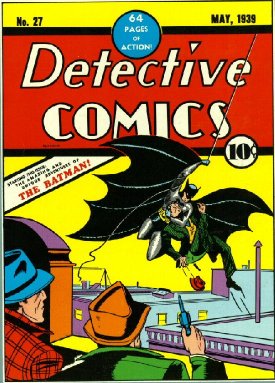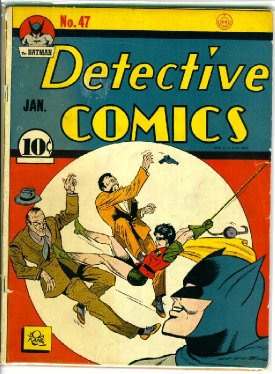|
The
Golden Age of Batman
(originally published in the August,
1975 issue of Once Upon A Dime)
Batman
was born in 1938 when teenage cartoonist Bob Kane
sat down to create a new Superman-type strip for
DC Comics. Inspired by the derring-do of Zorro,
the flying machines of Leonardo DaVinci and an old
movie called "The Bat Whispers", Kane
sketched a wing-cloaked avenger dressed in the colors
of the night. Kane christened his hero "the
Bat-Man" and teamed with writer Bill Finger
to produce the first Batman story for Detective
Comics #27, May 1939.
 The
Batman origin dreamed up by Finger and Kane is now
a standard of the genre. Ten-year-old Bruce Wayne
watches in horror as his mother and father are gunned
down by a petty thief. Raked with grief, the heir
to the Wayne fortune swears to wage a neverending
war against crime. He prepares his entire life for
this crusade. The
Batman origin dreamed up by Finger and Kane is now
a standard of the genre. Ten-year-old Bruce Wayne
watches in horror as his mother and father are gunned
down by a petty thief. Raked with grief, the heir
to the Wayne fortune swears to wage a neverending
war against crime. He prepares his entire life for
this crusade.
And
once he gains sufficient strength and knowledge
to fight crime, the adult Wayne realizes there's
one more thing he needs: a disguise that will "strike
terror into [the] hearts" of the underworld.
As if an omen, a bat crashes through his window
and Bruce Wayne thus decides to become the Bat-Man.
The
orphan angle is slightly derivative of the original
1938 story of Superman, who lost his parents when
the planet Krypton exploded.
Superman
and Batman are brothers of sorts. Superman is the
older, responsible one, but it's easy to be responsible
when bullets bounce off your chest. Batman, however,
constantly risks his life fighting crime. He's angry
and frustrated and this is the only way he can deal
with his childhood trauma. Superman is basically
a nice guy. If he was bitter about his parents'
deaths, he'd be waging a neverending battle against
exploding planets, not fighting for truth, justice
and the American Way.
After
a year's worth of stories showcasing Batman beating
up assorted crooks and dropping the occasional killer
in a vat of acid in the pages of Detective Comics,
the more recognizable elements of the Batman myths
began to appear. Robin, the Boy Wonder, came along
in 1940 and the legion of trademark villains like
the Joker, the Penguin, the Riddler and Catwoman
soon followed.
 Robin
is essential to the Batman legend. Youthful circus
aerialist Dick Grayson also saw his parents murdered
by criminals. By adopting Grayson as his ward and
providing him an outlet as Robin, Wayne is trying
to correct what went wrong in his own life. Wishing
there were someone not only to raise him after his
tragedy but also to help him avenge his parents'
deaths, Batman sees himself as the best possible
father figure to Dick Grayson. Robin
is essential to the Batman legend. Youthful circus
aerialist Dick Grayson also saw his parents murdered
by criminals. By adopting Grayson as his ward and
providing him an outlet as Robin, Wayne is trying
to correct what went wrong in his own life. Wishing
there were someone not only to raise him after his
tragedy but also to help him avenge his parents'
deaths, Batman sees himself as the best possible
father figure to Dick Grayson.
The
most familiar villains are those from the TV show,
many of which didn't exist in the comics series,
but there are really only three that matter: Catwoman,
Two-Face and the Joker.
Catwoman
is the only major female villain in the Batman annals.
She represents all the women Batman has shut out
of his life. Catwoman steals because it's the only
way to get the attention of the man she loves.
Two-Face
is lesser known to the general public, but he's
still a classic villain of Batman's golden age.
Two-Face used to be District Attorney Harvey Dent,
a friend and associate of Batman. After the left
side of his face was horribly disfigured by a criminal
he was prosecuting, Dent went crazy and adopted
the "double" motif that marks all his
crimes.
 Because
Two-Face is a lawman-turned-criminal, a friend gone
bad, he's Batman's worst nightmare. Bruce Wayne/Batman
is similarly schizophrenic - might he go over the
brink one day the way Harvey Dent did? Batman always
handles Two-Face with kid gloves, holding out hope
that Dent can reform and become a good guy again. Because
Two-Face is a lawman-turned-criminal, a friend gone
bad, he's Batman's worst nightmare. Bruce Wayne/Batman
is similarly schizophrenic - might he go over the
brink one day the way Harvey Dent did? Batman always
handles Two-Face with kid gloves, holding out hope
that Dent can reform and become a good guy again.
The
Joker, of course, is the ultimate Batman villain.
He's gone through many incarnations, from the ridiculous
to the sublime, but the best Joker is part psychopathic
killer, part irrepressible funster. The Joker's
humor-originated irrationality is the perfect counterpoint
to Batman's grim reliance on scientific principles.
In his first appearance, The Joker was a jewel thief
who murdered his victims with a toxin that gave
each corpse a ghastly grin. As the '40s and '50s
wore on, the Joker became more clownish and less
deadly, plotting relatively harmless, gimmick-laden
stunts rather than actual crimes.
The
other villains are all variations on a theme. The
Riddler, Penguin and company were all obsessives
who couldn't plot a crime without first clueing
in the Batman.
Why
were the villains the only ones afflicted with this
curious symptom? How come Batman never played fair
and sent the Riddler an advance warning: "What's
short, green and about to get arrested?"
In
the '50s, Batman got silly. When not confronting
offbeat menaces like "The Alien Boss of Gotham
City" and "The Valley of Giant Bees,"
the Caped Crusader was undergoing a bizarre assortment
of transmutations in stories like "The Merman
Batman," "The Caveman Batman," "Batman,
Indian Chief," "Batman of the Mounties"
and perhaps worst of all, "Batman Becomes Bat-Baby."
The
Golden Age of Batman was certainly over by then.
--
Carr D'angelo

|